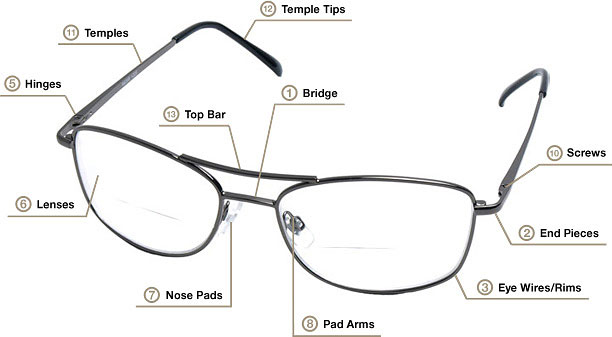
1. Bridge: The area that arches up over the nose between the lenses thus supporting the majority of the glasses weight. There are several different types of bridges:
- A keyhole bridge is shaped like an old-fashioned keyhole and rests on the sides of the upper part of the nose. This style is best suited for those with small or flat-topped noses.
- A saddle bridge is shaped like a saddle and spreads the weight of the frame across the sides and the top of the nose. This style works well for heavy glasses or for those with sensitive noses.
- An adjustable bridge includes nose pads that can be bended and moved for fit and comfort.
- A double bridge has a reinforcing bar over the top of the bridge.
2. End pieces: The portions of the frame front that extend outward from the lenses and connect to the temples.
3. Eye Wires/Rims: Part of the frame front into which the lenses are inserted.
4. Frame Front: (not pictured) Outermost front part of the eyeglass frame which holds the lenses in place and bridges the top of the nose; consists of bridge, end pieces, rims and lenses.
5. Hinges: Portion of the frame that connects the frame front to the temples and allows the temples to fold inward in a closing motion.
6. Lenses: Eyeglass parts which hold a wearer’s prescription.
7. Nose Pads: Plastic pieces which may be attached directly to the frame or pad arms. These help keep the frame in its proper position on the wearer’s face, while providing comfort and a snug fit.
8. Pad Arms: Attachments that hold the nose pads in place; typically allow adjustments so that they may conform to the wearer’s nose.
9. Rimless Frames/Mountings: (Not pictured)When the temples and bridge attach by mountings, or metal fixatives, directly to the lenses without the use of eye-wires or rims.
10. Screws: Tiny metal fasteners found at eyeglass hinges which connect the temples to the frame front; and on the bridge, which hold the nose pads in place.
11. Temples: “Arm” pieces of the frame that extend over and/or behind the ears to help hold the frame in place. There are several types of temples:
- Skull temples are most popular for plastic frames. They appear bent down slightly over the ear and follow the contour of the skull.
- Comfort-cable temples hook behind the ear with a flexible metal cable. These are suitable for children’s styles and sport-safety glasses.
- Riding bow temples are similar to comfort-cables, except they are rigid and made of plastic.
- Spring-hinged temples include hidden springs in the hinges that help keep the frame from slipping. These are sometimes more expensive, but typically more resistant to breakage.
- Library (or paddle) temples are straight, so they can be slipped on and off easily. This type is often used in reading glasses.
12. Temple tips: Plastic coatings that often cover the ends of the temples behind and/or over the ears to provide wearer comfort. Their use is common in regard to metal glasses.
13. Top bar: A reinforcing bar that crosses the top of the glasses, between the two lenses, on some metal frames; popular in aviator style glasses.
Photo and information courtesy of www.readers.com